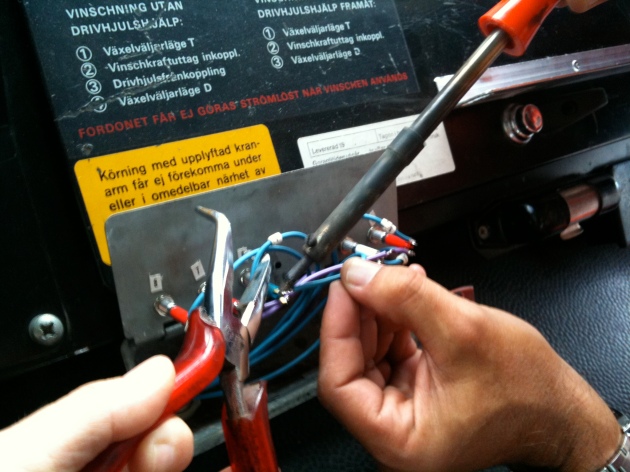Diagnosing the Transmission Anomaly
December 13, 2010 7 Comments
We spent some time this weekend making a micro-controller test platform to develop a new control unit for the EM-1 (Erg Machine 1) transmission. We’ll be reporting on that once we’ve made more progress, but now seems like a good time to describe our diagnosis of the gearbox error and the steps we took to make sure we didn’t have any problems because of the transmission while in Tunisia.
During the road test we experienced an intermittent problem with the transmission; from time to time when accelerating or decelerating the gear would not engage.
One of the nice things about the Scania SBA 111 is its automatic transmission. This makes it a good vehicle for a first big truck experience, since the driver can concentrate on driving and doesn’t have to worry about shifting the gears. It’s also great for dunes (as we learned), since there’s no worry about losing momentum when shifting gears. However, the downside is that the automatic transmission adds complexity to the maintenance and increases the number of potential failures.
The automatic transmission is a special feature of the military version of the SBA 111, so it’s not something that the Scania mechanics are familiar with, and we were more than a little worried when we experienced the problem just a few weeks before leaving for Tunisia. We had changed the transmission fluid during the general maintenance in July, and our first step was to verify that the anomaly wasn’t simply a matter of adjusting the level of the fluid. Since the level was correct, we were left with two sources for the problem: either the Electronic Control Unit (ECU) was faulty or there was a problem within the gearbox, such as a faulty servo. Neither of these were problems we wanted to encounter, but since disassembling the transmission was likely to be complicated, time-consuming and costly, we decided to see if we could rule out a problem with the ECU, which would be easier to fix or replace.
In order to test the ECU, we made a small monitoring tool that would provide a visual indication of the commands the unit was sending to the servos.
We converted the ashtray into a small device with 5 LEDs, one for each of the three gears (1,2,3), one to indicate activation of the torque converter (TS) and one to indicate activation of the mechanical clutch (M).
Using a schema of the ECU, we connected the LEDs to the proper outputs so that when the output was activated, the corresponding LED would turn on.
The goal was to see if the ECU was correctly sending the shift commands to the gearbox. The gearbox is composed of two groups; the first three gears are driven by the torque converter (1-3) and gears 4-6 are driven by the classical mechanical clutch. When upshifting or downshifting the manual describes the sequence of gears. When accelerating, the transmission will upshift through the gear sequence 1-2-3-6. When decelerating, the pattern is 6-5-4-1. When using the downshift, the entire range of gears will be downshifted, 6-5-4-3-2-1.
 If the ECU were faulty, the monitoring tool would allow us to identify the fault if a gear did not engage. Otherwise, if the LEDs indicated that the sequence of ECU commands was correct, then the failure of a gear to engage would likely indicate a problem with the clutch itself.
If the ECU were faulty, the monitoring tool would allow us to identify the fault if a gear did not engage. Otherwise, if the LEDs indicated that the sequence of ECU commands was correct, then the failure of a gear to engage would likely indicate a problem with the clutch itself.
Once the tool was installed we performed a series of test drives to observe the transmission in action. Here is a short video clip showing the tool in operation during a normal shift sequence.
Once the tool was operational we actually had to wait for some time for a shift failure to occur before we were able to completely observe the behavior of the ECU during the failure. We were not able to catch a clear failure sequence on video due to the intermittent nature of the problem, however we did observe some unexpected behavior in one video we took during a long uphill climb. The LED for the 2nd gear should not turn on/off at timecodes 00:34 and 2:20 in the following video.
The information provided by the tool allowed us to determine that the shifting errors were the result of a problem with the ECU. There was not enough time to replace the unit before departure since we did not have a spare and inspecting it would have been complicated because we would have had to open the transmission. We did rule out a problem with the wiring, however.
In order to ensure that we would not be stuck in the desert if the unit experienced a major failure, we installed interrupt switches on the monitoring tool that would allow us to manually command the ECU by flipping a switch to select the corresponding gear. As yet we don’t have a video demonstrating use of the modified unit, but it enables us to manually force a gear shift in case of ECU failure.
Since we installed the unit, it has proved useful on several occasions.
Update (Oct 25, 2011): We’ve made an electrical schematic of the ECU Override Unit.
The device is good for monitoring and to be able to move the truck in case of an ECU failure. It is not intended to drive the truck during normal operations but is more like an emergency device. Here is a video of the unit in operation.




Pingback: Gearbox ECU Override Unit « Erg Machine
Hi!
Thanks for great website. I have same kind of problems with scania gearbox. Your information has been useful. How did you actually connect the indicator leds and force switchs? I’m thinking to built same kind of unit. you can reply to my email.
Hello,
Glad you found this information useful. Connecting the LEDS and switches is quite straightforward. We took a +24v source and distributed it over the switches input. We connected the output of each switch to the corresponding solenoid (electro-valve) as shown in the images above. From the output of each switch we connected a LED, which was connected to the ground. To avoid burning out the LED, you must add a resistor. We used a special part consisting of a LED + a resistor for use at 24v. The output of the switches is also connected to the ECU. Note that the LED acts like a freewheel diode so if you need to completely disconnect the original ECU this will function without any problem for the solenoid.
We updated the post with an electrical schematic of the unit.
Thank you for the information. I have a related problem, with a truck TGB30, in Bolivia. There is something I don’t understand, if the gear M1 is obtained through the connection of solenoide 521 and 525 (M1=1+TS), and the gear M2 is obtained through the connection of solenoide 522 and 525 (M2=2+TS). But I observed in the video that M2 has the LED 1, LED 2, and LED TS on simultaneously (M2=1+2+3). I understood that if gear M1 and M2 is actionated at the same time the gearbox will be broken… what is avoiding that gear M1 and M2 gets shifted?? I appreciate your help.
Glad you found this post helpful.
The M1 gear activates the following solenoids: M + TS + 1 (connector 524 + 525 + 521). The TS + 1 is the H1 gear (525 + 521).
The TGB ECU upshift pattern is H1 -> H2 – > H3 -> M3 and the downshift is M3 -> M2 -> M1 -> H1.
The upshift pattern activates the following solenoids:
H1 (TS + 1, 525 + 521)
H2 (TS + 1 + 2, 525 + 521 + 522)
H3 (TS + 1 + 2 + 3, 525 + 521 + 522 + 523)
M3 (TS + M + 1 + 2 + 3, 525 + 524 + 521 + 522 + 523)
The downshift pattern activates the following solenoids:
M3 (TS + M + 1 + 2 + 3, 525 + 524 + 521 + 522 + 523)
M2 (TS + M + 1 + 2 , 525 + 524 + 521 + 522 )
M1 (TS + M + 1 , 525 + 524 + 521 )
H1 (TS + 1, 525 + 521)
If you try to active M1 and M2 -> (TS + M + 1) and (TS + M + 1 + 2) the result will be the activation of (TS + M + 1 + 2 ) which is the M2 gear.
As long as the TS solenoid is not active, the gear box is not engaged. The TS activates the torque converter. If the torque converter is not active, the gear box is in a “neutral” position (there is no link between the engine and the power train).
As you can see for the upshift and downshift sequences, only one solenoid is activated/de-activated in each step. The downshift is different from the upshift to take advantage of the engine braking.
I hope this helps and the explanation is clear. Thanks too for your question. It turns out there was an error in the post concerning the downshift sequence. This error has now been corrected.
Hi there,
Great website you got about the Scania.
Did you ever consider to remove the automatic gearbox for a manual gearbox ?
And what would you do if there is a serious brakedown in the automatic gearbox?
It seems that new ECU are just not available anymore.
With kind regards, Mike.
Hi Mike,
Thanks for your comment.
In fact on this Scania, the gearbox has been specifically developed for it (military application), including the gearbox (obviously) and a transfer case with 2 gears (low and high), so to swap this gearbox GA763 for a manual one, we would also have to find a transfer case to bring traction to the front and rear axle when engaged. The engine is a standard Scania and its engine/clutch housing is not specifically developed for the military so the engine could be potentially coupled to a standard Scania gearbox (the one that is used on the same engine) but in this case a transfer case needs to be installed, and I don’t think it will be necessarily easy. One additional parameter to take into account is the length of the manual gearbox plus transfer case compare to the GA763 which is fairly compact.
The ECU is indeed a potential problem. It seems that the diode used (the free wheel diode 1N…) could be damaged, which is one of the ECU faults. The second problem that may happen is the PCB, for example some lines could be disrupted on the PCB which create bad connections. We have a plan to replace it with a micro-controller but we don’t have time to work on this project at the moment. In the meanwhile, we have installed several switches (as shown in the blog post) to directly the gearbox for engaging the right gear if needed.